How to Grow False Bird of Paradise (Heliconia)

False bird of paradise (Heliconia) is a colorful, exotic plant with small flowers. Native to tropical Central and South America and the southwest Pacific, the false bird of paradise is a species of perennial herb in the Heliconiaceae family.
Due to its similarity to the bird of paradise flowers, the false bird of paradise is one of the most popular names for referring to this plant. It has other common names such as lobster-claws, toucan beak, and wild plantains as well.
False bird of paradise vs bird of paradise
You can easily mistake a bird of paradise or Strelitzia with an actual bird. Native to South Africa, this gorgeous plant is a species of evergreen tropical herbaceous plant (unlike Heliconia). Bird of paradise is closely related to bananas, and some people confuse it with a banana tree because of their similarity. This plant got the name bird of paradise for having charming, orange crane-like flowers.
Bird of paradise has split leaves that give it its bird-like shape. Scientists believe that the purpose of the leaves tearing is to reduce drag in the wind; so that the plant can eliminate the risk of breaking in half by strong winds. In the following, we are going to describe Heliconia to understand the Difference between bird of paradise and false bird of paradise better.
Also, you may be interested in our article about Mexican bird of paradise plant.
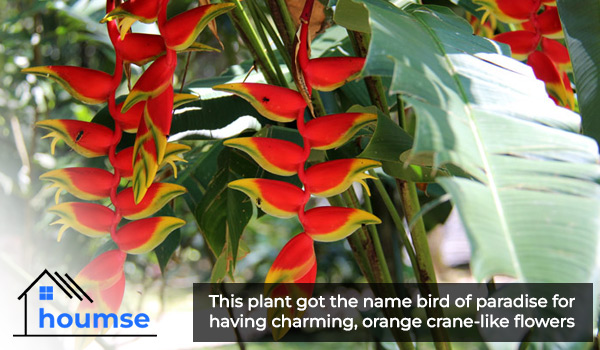
Heliconia Description
As the only genus in the monotypic family Heliconiaceae and family Musaceae (which includes bananas too), false bird of paradise is known by different names. The name Heliconia comes from Mount Helicon, a mountain in southern Greece. This mountain in Greek mythology is the home of the Muses, the goddesses of the arts, literature, and science.
The name ‘Lobster Claw’ refers to the shape of false bird of paradise leaves, resembling the shape of a lobster’s claw. We also mentioned that the name false bird of paradise comes from its similarity to Strelitzia flowers.
Let’s know the appearance of this plant better.
False Bird of Paradise Size
The simple leaves of this plant can grow between 6 inches to 10 feet (15 to 300 cm). They are long, oblong, and grow alternate or opposite to one another. If kept in a tropical location, the fronds will be evergreen. In cooler environments, they naturally die back in cold weather (50 °F or lower).
Conditional to the position, each leaf has a different potential for absorbing sunlight when exposed to different degrees of sunlight. As we said, you cannot ignore how they look like lobster claws. Depending on the species, the false bird of paradise’s height can vary from 2 feet (60 cm) to 20 feet (6 m) tall.
False Bird of Paradise Flower
The beautiful color of this plant’s flowers ranges in hues of red, orange, yellow, and green. Interestingly, false birds of paradise’s flowers are in fact modified leaves called bracts. These bracts contain real, tiny flowers inside them. The false bird of paradise flower also produces ample nectar that attracts pollinators, especially hummingbirds.
Is False bird of paradise Annual or Perennial?
This plant is a species of perennial herb that blooms in spring and summer (if planted in the ground), and anytime if it is pot planted.
Is The False Bird of Paradise Toxic?
As beautiful as they are, these plants are toxic to cats, dogs, and horses. If parts of them are eaten, vomiting, nausea, and a loss of appetite can happen. Consuming large quantities requires quick medical assistance too.
Now that you are quite familiar with this impressive plant, let’s see what its requirements are.
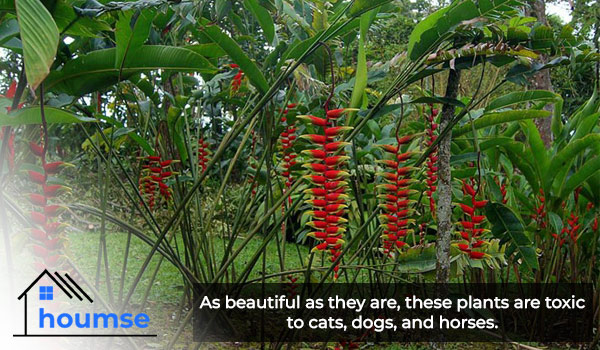
False bird of paradise Care Indoor
False bird of paradise care can be easier than you think. If you are planning to cultivate them as ornamentals, here are their vital needs:
Water
It is best to let the top few inches of the soil dry before watering in spring and summer. Remember that you need to reduce the amount of watering in false bird of paradise winter care. Heliconia can survive short droughts, but do not be tempted to test their strength. This may cause the plant not to bloom during the spring.
If you live in a dark location, do not moist the soil as frequently as the ones who live in brighter locations do. This is necessary to avoid root or rhizome rot. Other over-watering results are rotten or soft stems, and rapidly declining plant health.
In false bird of paradise care, pay attention to yellow or brown-edged leaves, flower loss, and slowed growth as well. These signs tell you that you are under-watering the false bird of paradise, you are re-poting it more than usual, or the plant is getting too much sunlight.
Soil
False bird of paradise care requires rich soil (houseplant compost is perfect). This plant grows best in acid soil. If you use alkaline soil, occurring yellow leaves with green veins could be inevitable.
For caring false bird of paradise indoors, we recommend a light and well-drained soil that stays consistently moist. For outdoors, the soil must not dry between irrigations during the spring and summer.
Light
False bird of paradise loves bright, indirect light. Little light will lead to slowed growth and no flowers. Too much light has a similar effect on the growth rate as well as scorching it.
If you cannot provide a place with the full or partial sun for your majestic plant, dust its leaves frequently to increase the light-absorbing efficiency and better photosynthesis. Dust the leaves at least once a week if you are in a colder climate with fewer sunlight hours.
Tip: While this is optional, you may want to clean the leaves with a wet sponge and a mild detergent (after testing it on one leaf).
Temperature
Moderate temperatures between 60 ℉ to 75 ℉ are excellent for growing false birds of paradise. Do not allow your plant to experience temperatures below 54 ℉ or the cold shock can harm or even kill the specimen.
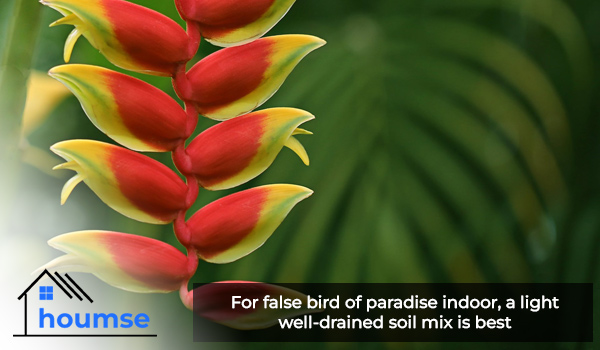
Humidity
Since the false bird of paradise favors humid environments, it is a good idea to provide a humidity tray for maintaining a stable humidity level for your plant. This is because Heliconia requires consistent misting to prevent browning leaf tips and the absence of flowers.
But keep in mind that high humidity along with poor air circulation can increase the chance of white mildew appearing on the leaves and the stem. If this happened to your beautiful plant, move it to a bright location, and remove or cut the sick leaves.
Tip: Browning on the leaf edges indicates low humidity.
Fertilization
During the Heliconia growing period, fertilize every two weeks using houseplant feed or half-strength Ericaceous plant fertilizers. Similar to watering, reduce fertilization in the winter. Over-fertilizing false bird of paradise results in the burning of roots, which lead to yellow leaves and sluggish growth.
Air Circulation
The false bird of paradise thrives in humid conditions. So, it is essential to ensure proper air movement around this species. Adequate air circulation prevents mildew and fungus.
In order to enhance it, you may use stakes to keep the foliage off the soil and separate from bunching. This way, the plant will not become too dense to trap moisture. False bird of paradise pruning is beneficial too. However, if you have a lot of plants that need high levels of humidity or a bad fungus problem, consider using air circulators.
Pruning
In addition to other benefits, with pruning, you can the plant grow new, healthier leaves. Use clean, disinfected pruners or shears to cleanly cut damaged, dead, or dying leaves. Try this instead of allowing them to wilt to keep your plant neat and tidy.
Potting and Re-potting
Similar to other Heliconia species, the false bird of paradise develops large rhizomatous root systems that can outgrow its container quickly.
Therefore, it is recommended to repot your plant every year using a ‘Houseplant’ labeled compost and the next sized pot. Regular re-potting also gives a great chance to check the roots’ condition or dividing basal offsets.

False Bird of Paradise Winter Care
This species does enter a dormancy period and you need to make sure it winterizes properly or smaller or no blooms next spring has a high possibility.
Here is what you need to know about false bird of paradise winter care. If these steps are followed successfully, you will enjoy the blooms in the following summer. However, keep in mind that nature may not always provide the results we are hoping for.
- Sunlight and Location: Place your plant in a bright spot with little to no direct sunlight. Also, make sure to avoid deep shade, using artificial lighting at night, or placing the plants in locations hotter than 64 ℉.
- Watering: Reduce watering so that at least half of the soil becomes dry. Do not worry about keeping it on the drier side, this is better for your plant throughout its dormancy.
- Feeding: During cold seasons, while the flowers are in development or in bloom, apply a tomato fertilizer at monthly intervals to provide the required potassium for your plant.
- Temperature: This is the most significant part of the false bird of paradise winter care. reduce the temperature down by around 41 ℉ or place it in a room that is between 59 ℉ to 62 ℉.
In a nutshell, reduce everything!
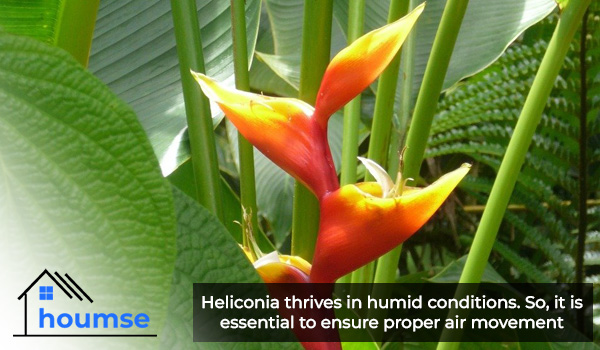
False bird of paradise Heliconia Common Issues
Caring for this heavenly plant is definitely worth your while. But sometimes it can become an inconvenience as well. Here, we are going to cover the common issues with this plant and how to avoid them.
Invasive Growth
Sometimes growing the false bird of paradise can be a ‘huge’ success. Invasive may be too strong for this charming plant, but it can take over a bed quickly and even move into your lawn.
As a solution, consider root barriers, occasional cleaning of the bed, division, resetting of rhizomes, or planting the small forms of Heliconia that are easy to keep inbound.
Transplanting Shock
When it comes to transplanting Heliconia, the shock can be a serious issue after repotting it. To avoid this, let your false bird of paradise soak for 24 hours before repotting, and do not play with the roots at all (unless you are dealing with a root rot).
Transplant shock hints are similar to under-watering, which are wilting, yellow leaves, and slow-paced growth.
Root Rot
As mentioned, root rot is a common issue in these plants. The main outcome of this problem is quickly yellowing leaves, slow growth, and stem collapse.
To deal with root rot, gently remove the false bird of paradise plant from the soil and check the root system. If it shows a yellow tinge, everything is fine. But if they seem brown and soft, you need to act quickly.
Problems with Leaves
The most important issue with leaves includes curled-up leaves with brown edges. Such symptoms let you know that the plant is getting too little water and probably too much light, or you are re-potting it more than needed.
Since false bird of paradise Heliconia has a sizeable root system, we suggest that you consider a transplant instead of constant repotting.
Pest Damage
Pest damage is a probable issue among plants. For this plant, spider mites and mealybugs could be your main problem. To see if these inhabitants have colonies on your plant, check the leaves’ undersides and along its central midrib.
The tiny and almost clear spider mite moves around the leaves to find chlorophyll. On the other hand, mealybugs are white, and you can easily notice them after some time. You need to destroy their colonies (that have the eggs inside) as soon as you notice them reduce their population.
Lack of Flower
This unpleasant issue could be the result of different matters including irregular watering, too little light, and not enough fertilization. Because a false bird of paradise takes many years to mature, its blooms may need up to six years to appear.
During the flowering period (summer), you should not use cold water for irrigation. Sudden changes in temperature can shock your plant and prevent it from blooming later.
Low-quality growing conditions can create problems for your beautiful plant as well. So do not place it in too bright or too dark locations. Also, provide the proper humidity level by finely misting the leave twice a week. When misting, keep the flowers dry to reduce the chance of botrytis petal blight or powdery mildew attacking your plant.
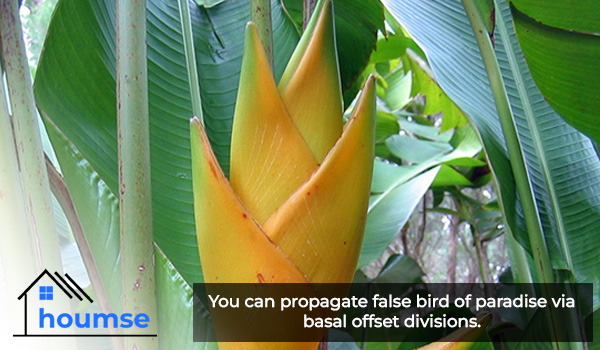
False Bird of Paradise Propagation
You can propagate false bird of paradise via seeds and basal offset divisions. Compared to sowing false bird of paradise seeds, the latter method is easier. Separating the basal offsets into individual pots slows the process of becoming pot bound as well as helping you expand your plant collection.
The best time to divide basal offset is during the spring or summer. During this time, choose a pup taller than 10 cm and follow these steps:
- Carefully brush away the soil as much as possible for better access to the pup’s base, where its roots will be housed.
- Cut the offshoot with at least two root strands attached to the base using a clean pair of scissors.
- Plant the false bird of paradise’s pup in an appropriate-sized container with drainage holes filled with a houseplant-labeled compost.
- Place the container in a spot with bright, indirect light and temperatures above 59 ℉.
- Keep the potting soil moist and allow the top third to dry out between irrigations.
After a couple of months, you can treat this young plant like a matured specimen using the care tips mentioned earlier.
- In this post:
- False bird of paradise vs bird of paradise
- Heliconia Description
- False bird of paradise Care Indoor
- False Bird of Paradise Winter Care
- False bird of paradise Heliconia Common Issues
- False Bird of Paradise Propagation



